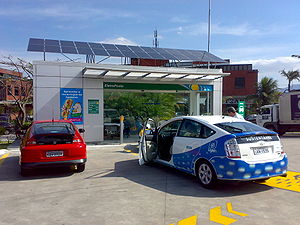
- Image via Wikipedia
IN THE ten years since hybrid electric vehicles first hit the highways and byways of America, they have come to represent 2.5% of new car sales. Yet, in places like Los Angeles, the San Francisco Bay Area and Washington, DC, every other car seems to be a Toyota Prius. That is because hybrids like the Prius have sold overwhelmingly where well-heeled early adopters reside.
Expect the new generation of “Post-Prius” electrics—plug-in hybrids like the Chevrolet Volt from General Motors and those relying only on a battery such as the Nissan Leaf—to end up nosing around the same upscale neighbourhoods. With more than a dozen plug-in and pure-electric models arriving in showrooms over the next year or so, sales are expected to outstrip even those enjoyed by the Prius and other hybrids in their early days. A couple of million of the new electric vehicles could be bought by early adopters during the first few years.
That would be a problem. Unlike the Prius and its ilk—which use their petrol engines, along with energy recovered from braking, to recharge their batteries while motoring—plug-in hybrids and pure electrics have to be recharged direct from the grid. The popular assumption is that they will be plugged into a wall socket in the garage late at night, taking advantage of cheap off-peak power. Unfortunately, things are not that simple.
For a start, the new generation of electric vehicles are not glorified golf-carts, but cleaner and more frugal alternatives to today’s petrol-powered family cars. When fully charged, the Volt (to be called the Ampera in Europe) can travel 40 miles (64km) on electric power, enough for three out of four commuters in America to get to work and back without needing to burn a single drop of fuel. Beyond that range, a 1.4-litre engine kicks in to generate electricity and simultaneously propel the car and recharge its batteries.
The medium-sized hatchback Leaf can carry five adults 100 miles on a single charge. To go farther, Nissan has put its faith in a network of rapid-charging stations it is developing with partners. The Leaf is expected to cost $25,000-30,000, about the same as a comparable diesel-powered car. But the battery pack will have to be leased separately (for around $150 a month).
One thing the new plug-ins and pure electrics have in common is a beefy lithium-ion battery pack that needs a lot of heavy charging. At the very least, that involves installing 220-volt wiring in the home. Trying to recharge a modern electric car with a standard American 110-volt supply takes too long to be practical (up to 18 hours in the case of the Leaf).
Related articles by Zemanta
- Study: Batteries – and EVs – Won’t Get Cheaper Anytime Soon (wired.com)
- Electric cars struggle to spark enthusiasm (guardian.co.uk)










